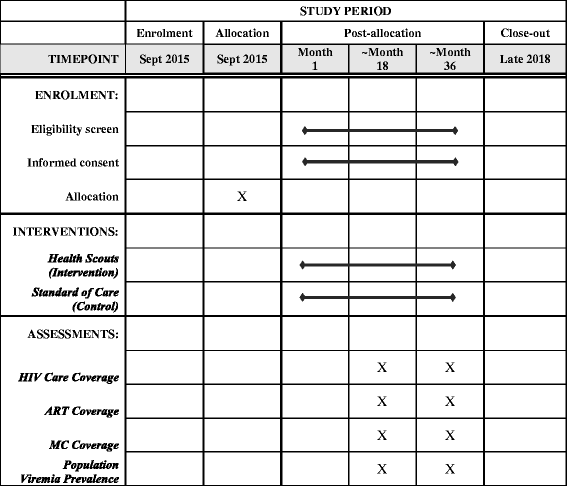Impact of a community health worker HIV treatment and prevention intervention in an HIV hotspot fishing community in Rakai, Uganda (mLAKE): study protocol for a randomized controlled trial
- PMID: 29061194
- PMCID: PMC5654192
- DOI: 10.1186/s13063-017-2243-6
Impact of a community health worker HIV treatment and prevention intervention in an HIV hotspot fishing community in Rakai, Uganda (mLAKE): study protocol for a randomized controlled trial
Abstract
Background: Effective yet practical strategies are needed to increase engagement in HIV treatment and prevention services, particularly in high-HIV-prevalence hotspots. We designed a community-based intervention called "Health Scouts" to promote uptake and adherence to HIV services in a highly HIV-prevalent fishing community in Rakai, Uganda. Using a situated Information, Motivation, and Behavioral skills theory framework, the intervention consists of community health workers, called Health Scouts, who use motivational interviewing strategies and mobile health tools to promote engagement in HIV treatment and prevention services.
Methods/design: The Health Scout intervention is being evaluated through a pragmatic, parallel, cluster-randomized controlled trial with an allocation ratio of 1:1. The study setting is a single high-HIV-prevalence fishing community in Rakai, Uganda divided into 40 contiguous neighborhood clusters each containing about 65 households. Twenty clusters received the Health Scout Intervention; 20 clusters received standard of care. The Health Scout intervention is delivered within the community at the household level, targeting all residents aged 15 years or older. The primary programmatic outcomes are self-reported HIV care, antiretroviral therapy, and male circumcision coverage; the primary biologic outcome is population-level HIV viremia prevalence. Follow-up is planned for about 3 years.
Discussion: HIV treatment and prevention service engagement remains suboptimal in HIV hotspots. New, community-based implementation approaches are needed. If found to be effective in this trial, the Health Scout intervention may be an important component of a comprehensive HIV response.
Trial registration: ClinicalTrials.gov, ID: NCT02556957 . Registered on 20 September 2015.
Keywords: Adherence; Antiretroviral therapy; Community health workers; HIV; Male circumcision; Motivational interviewing; Randomized controlled trial; Uganda; mHealth.
Conflict of interest statement
Ethics approval and consent to participate
The study has been approved by the Research and Ethics Committee of the Uganda Virus Research Institute (GC/127/16/06/505), the Ugandan Council of Science and Technology (SS 3868), the Western Institutional Review Board (20031318), and the Johns Hopkins School of Medicine Institutional Review Board (IRB00062089). All participants provided oral and written consent and assent as appropriate.
Consent for publication
Not applicable.
Competing interests
emocha Mobile Health Inc. is the company that developed and supported the smartphone application used in this protocol. LC and RB are entitled to royalties on certain non-research revenue generated by this company and own company equity. Specific to this study, LC and RB have and will receive no royalties or compensation from emocha Mobile Health Inc. This arrangement has been reviewed and approved by the Johns Hopkins University in accordance with its conflict of interest policies. LC and RB will not be members of the DMC established for this study. All other study team members have no known competing interests.
Publisher’s Note
Springer Nature remains neutral with regard to jurisdictional claims in published maps and institutional affiliations.
Figures







References
-
- UNAIDS . Report on the Global AIDS Epidemic. Geneva: UNAIDS; 2013.
Publication types
MeSH terms
Substances
Associated data
Grants and funding
LinkOut - more resources
Full Text Sources
Other Literature Sources
Medical

